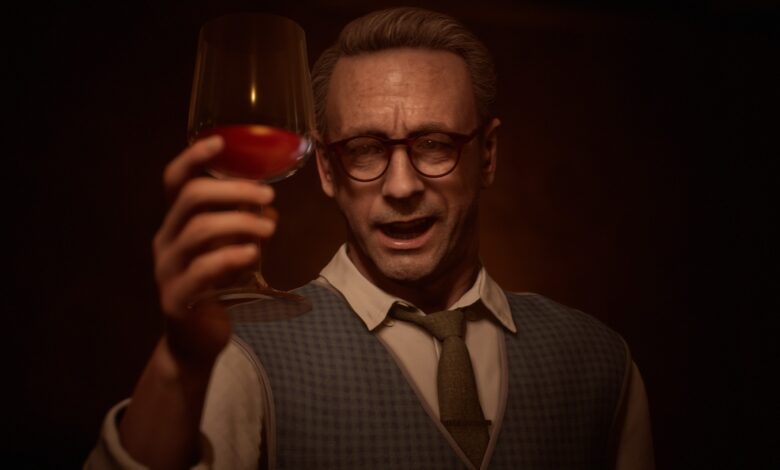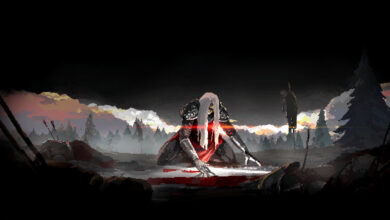
I’ve been a big fan of Supermassive’s Dark Pictures Anthology since it kicked off with Man of Medan a few years ago. The standalone episodes capture the best bits of schlocky B-movie horror romps, but with a flashiness and level of polish that their film counterparts don’t have. These 6-hour interactive horror movies are at their best, however, when played with a friend. At least that was the case until The Devil in Me, the latest and by far the weakest entry in the series.
The Dark Pictures Anthology has two multiplayer modes. There’s a pass-the-controller mode for up to five players, with everyone picking a character, and a two-player co-op mode where you keep switching who you’re playing. The latter is my preference, since it allows you to play remotely, and that really ramps up the scares. It’s incredibly unnerving to have to translate the screams and panicked yammering of your co-op partner (it’s usually me doing the screaming and yammering) when they’re faced with something you can’t see because you’re not in the same room—in the real world, or the game.
(Image credit: Bandai Namco)
After House of Ashes, the best of the anthology so far, I was very keen to get stuck into The Devil in Me. Every episode has drawn inspiration from ghost stories, history and mythology, but The Devil in Me feels the most rooted in real-world horror, based as it is on the nightmarish crimes of H. H. Holmes, America’s first serial killer.
Holmes was executed in the 19th century, but in the present day a group of documentarians decide to make a film about the monster, naturally finding themselves in a creepy murder house for the purposes of research. After a solid prologue set during Holmes’ life, we’re quickly introduced to the modern-day cast, and it’s all downhill from there.
Between a creepy dude dressed up as Holmes who’s stalking the crew, and the house’s multitude of Saw-like traps and torture devices, there are a lot of opportunities to kill off the cast, and since nearly every single one of them is simultaneously horrible and boring, you might not work very hard to save them. Even if you want them all to get out alive, however, bugs and weird design choices will make that a big challenge.
(Image credit: Bandai Namco)
This is a buggy game overall, but it’s especially messy in co-op. Straight away I noticed that The Devil in Me really struggled to animate my co-op partner. Instead of crawling, they slid along the floor, and instead of walking across a log, they just slid, yet again. Sometimes they’d simply vanish, leaving behind a torch or camera hovering in mid-air. Or they’d get stuck in a T-pose.
It’s hard to immerse yourself in the horror with all this nonsense going on.
It’s hard to immerse yourself in the horror with all this nonsense going on, but it’s not just visual incongruities. When trying to stop a moving wall from breaking a character’s hand, we both succeeded in the QTE, but we failed anyway. And the same thing happened again when we were both holding our breath while hiding. Failed QTEs frequently end badly, so it’s a pretty critical issue when they bug out.
The Dark Pictures Anthology is not a tricky series. You’re unlikely to ever get stuck. But The Devil in Me bucks this trend. In one sequence, I had to use a microphone to find out what room some moaning was coming from. It directed me towards a locked door—it didn’t require a key, it simply wasn’t interactive. I ended up having to go in a completely different direction, and instead of following the sound, I just wandered around aimlessly until something happened.
(Image credit: Bandai Namco)
The murder house, aside from a few rooms, is a pretty dull maze, where you’ll spend most of your time awkwardly walking around and shouting at the camera, which constantly gets stuck or obscured by another character. This is made even worse by broken prompts.
When you’re rooting around for stuff in the dark, in a house where most things aren’t interactive, you really have to rely on these prompts to progress. Without them, it’s very hard to tell if a tiny gap is one you can fit through, or if this door is one of the few that you can actually open. And that’s why we spent what felt like an eternity walking around a swimming pool when the prompt to exit the area simply didn’t show up. I lost track of the number of times a prompt only appeared after I’d hit the button out of desperation.
(Image credit: Bandai Namco)
None of these issues are one-offs; they happened over and over again. And thanks to the immensely unlikable characters and the tiresomely slow pace—I was pleading for some actual scares instead of more hiking expeditions around the houses’ expansive grounds—there’s nothing to make up for all the issues.
I have to wonder if this huge dip in quality is down to Supermassive splitting its attention between The Quarry and The Dark Pictures Anthology. The former, also recently released, is quite a bit larger than the anthology episodes and would have been developed concurrently. It would explain why The Devil in Me wasn’t ready for prime time. And it’s a shame, because the setup is fantastic, and the Curator—the one common thread throughout the anthology—is at his most mysterious and meta. I wanted to keep playing, but also very much wanted to stop.






